Brainstorming New Ideas For Improved Stormwater Infrastructure


Planning how to address environment-impacting, water-infrastructure challenges — reducing stormwater runoff pollution, reducing sewer overflows, and protecting rivers and streams that serve as drinking water supplies for downstream towns — can be an intimidating task. A recent report from the Environment America Research & Policy Center cites many examples that can serve as beacons for municipalities large and small.
Learning From The Experience Of Others
For decision-makers confronted by stormwater, combined sewer systems, aging wastewater infrastructure, and other environmental challenges, A Path To Cleaner Water identifies more than 20 idea-generating projects. It also includes more than 120 unique URL links to supporting information to enable interested parties to learn about them in greater detail. The combined coverage shares a wealth of insights to projects large and small — from small, stormwater solutions to multifaceted, billion-dollar projects that were a decade or more in the making. Examples include both gray and green infrastructure projects — many of them financed by combinations of local, state, and federal funding including Clean Water State Revolving Funds and Clean Water Act Section 319(h) funds.
Goals of the various projects ranged from improving health protections related to the impacts of combined-sewer overflows (CSOs)/sanitary-sewer overflows (SSOs) to improving wildlife habitat to expanding human recreational opportunities. The report also addresses stormwater impacts resulting from increased frequency and severity of rainfall events and from rising sea levels in different areas of the U.S.
From Ounces Of Prevention To Tons Of Cure
Many of the smaller projects cited in the report are designed to avert larger problems by dealing with local stormwater drainage through site-specific green infrastructure. They include:
- reducing runoff-carrying nutrients from agricultural fields, fecal matter from wildlife, and chemicals from impervious surfaces,
- reducing CSOs and SSOs in aging wastewater infrastructure, and
- reducing the compounding effects of inflow and infiltration in sewer lines.
Some of the larger projects incorporate combinations of green infrastructure along with highly engineered gray infrastructure to reduce large-scale problems dramatically across major metropolitan areas.
Here is a cross-section of the challenges addressed:
- Local CSO Mitigation (St. Johnsbury, VT). As one of 14 municipalities in Vermont with combined-sewer systems, St. Johnsbury had multiple outfalls that drained into the Passumpsic River, a tributary of the Connecticut River. A $600,000 investment in the town’s first neighborhood-scale green stormwater infrastructure project was just one of multiple CSO-mitigation efforts that will pay dividends in the greater Connecticut River Valley for years to come.
- Stormwater Relief (Wilmington, DE). The City of Wilmington is taking bold steps to relieve flooding in a particularly vulnerable area of the city. Segregating stormwater inlets from combined-sewer pipes in a 36-acre area will practically eliminate 2.1-million gallons of stormwater and sewage CSOs during severe weather events. Stormwater is being redirected to 14 acres of restored wetlands, where it can be filtered naturally before being discharged into the Christina River. The project is expected to reduce the prior flood-prone coverage area by 96 percent.
- Stream Rehabilitation (Auburn, AL). Not all environmental rehabilitation efforts are multimillion-dollar infrastructure projects. Some just provide a little assistance in the form of improved natural structures to let Mother Nature do most of the work. This Mill Creek watershed project — including a section of it running through the campus of Auburn University — was a collaborative effort among a number of environmental groups that used multiple funding sources to restore the watershed.
- Metro-Area CSO Relief (Chicago, IL). At the time of its completion in 2015, the Thornton Composite Reservoir’s 7.9-billion-gallon capacity made it the largest combined-sewer reservoir in the world. Within its first two years of operation, the reservoir and 109-mile tunnel system feeding it had stored more than 38 billion gallons of sewage for subsequent treatment, preventing it from spilling into local waterways during CSOs.
- The ‘Big-Pipe’ Project (Portland, OR). This $1.4-billion, 20-year project married a combination of traditional structural approaches with green infrastructure to reduce CSOs to the Willamette River by 94 percent and CSOs to the Columbia Slough by 99 percent.
One point that stands out in the report is that, in many of the projects, the work was neither undertaken nor financed exclusively by a water or wastewater utility. Collaboration among environmental groups, municipalities, and water utilities was common. Also, funding was shared among different influences and derived from a number of different private, local, state, and federal sources all coming together to support shared objectives. This underscores the importance of viewing wastewater-utility concerns in a broader context and developing relationships with like-minded influencers to support outcomes that might never occur under a utility-only approach.
About Environment America
According to its website, Environment America is a network of 29 state environmental groups focused on timely, targeted action that makes tangible improvements in the quality of the environment. Its mission is to transform the power of imagination and ideas into change that makes the world a greener and healthier place for all. Its focal points include clean water and air; clean, green, and renewable energy; conservation; global-warming solutions; and environmental defense.
